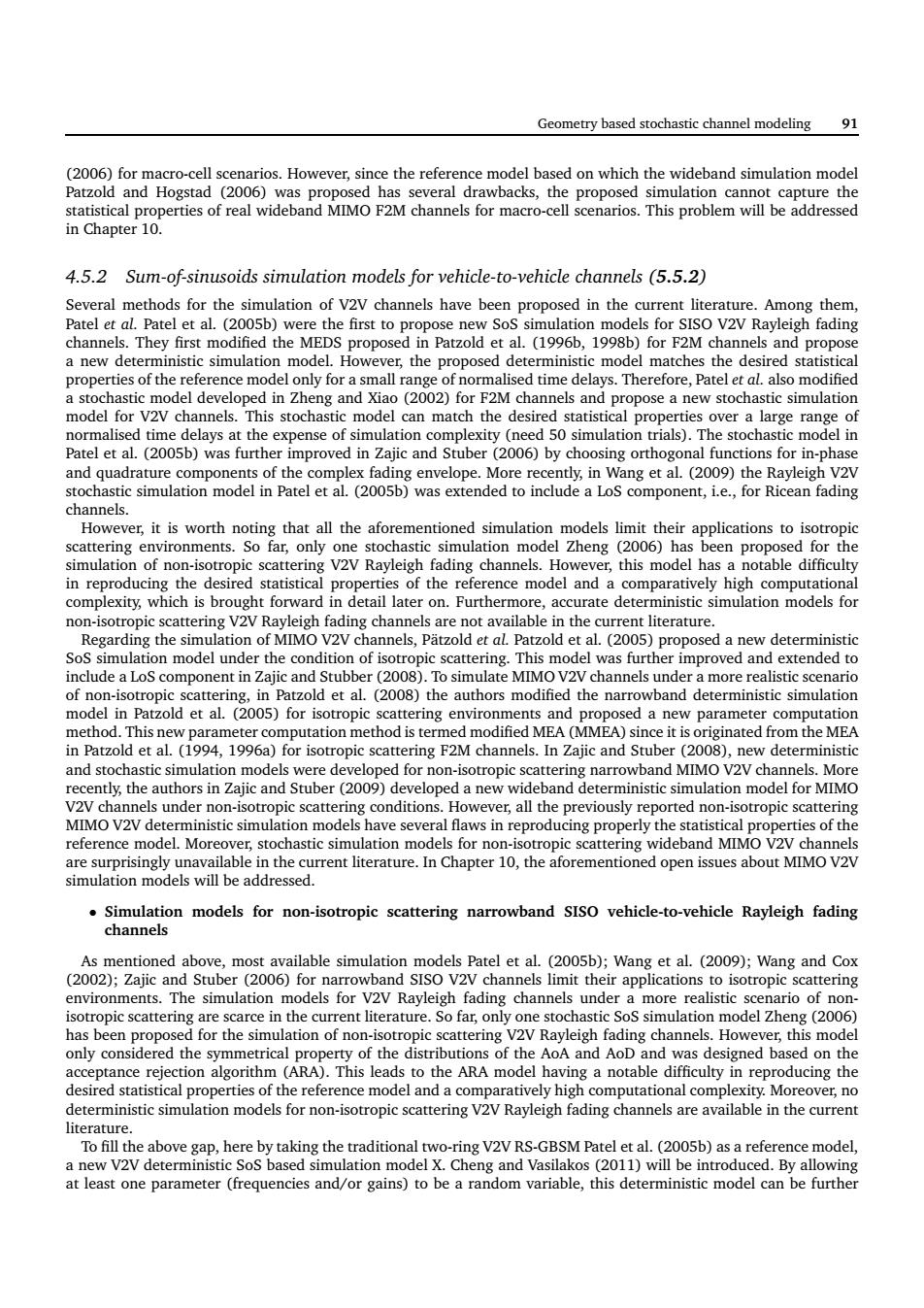正在加载图片...

Geometry based stochastic channel modeling 91 wideband simulationm ed si 4.5.2 Sum-of-sinusoids simulation models for vehicle-to-vehicle channels (5.5.2) Amo channels They first modih the MEDS proposed in Patzold eta a.1996b,1998 )for F2M channels and propos normalised time delays at the expense of simulation com plexity(need 50 simulation trials).The stochastic model in Patel et al.(2005b)was further improved in Zajic and Stuber( 2006by choosing orthogonal functions for in-phase channels. simulation of no this m notable difficulty nd non-isotropic scattering V2V Rayleigh fading channels are not available in the current literature. nels,Pat the includeaLcmnand Srubber ().To simulate MIM OV2V channels under a more realistic scenario et omputation method is terme d modified MEA(N MMEA) sin ce it isoriginated from the ME 1996 for isotropic scatt ering F2 nels.In Zajic and Stu owever,all t about MIMO V2V Simulation models for non-isotropic scattering narrowband SISO vehicle-to-vehicle Ravleigh fading channels environments.The simulation models for V2V Rayleigh fading more realistic sce ario of non au far,o V2V Ra igh fadi this mode per fthe distributions of th AoA and AoD designed ba d on th e model and deterministic simulation models for non-isotropic scattering V2V Rayleigh fading channels are available in the current al.(2005b)asGeometry based stochastic channel modeling 91 (2006) for macro-cell scenarios. However, since the reference model based on which the wideband simulation model Patzold and Hogstad (2006) was proposed has several drawbacks, the proposed simulation cannot capture the statistical properties of real wideband MIMO F2M channels for macro-cell scenarios. This problem will be addressed in Chapter 10. 4.5.2 Sum-of-sinusoids simulation models for vehicle-to-vehicle channels (5.5.2) Several methods for the simulation of V2V channels have been proposed in the current literature. Among them, Patel et al. Patel et al. (2005b) were the first to propose new SoS simulation models for SISO V2V Rayleigh fading channels. They first modified the MEDS proposed in Patzold et al. (1996b, 1998b) for F2M channels and propose a new deterministic simulation model. However, the proposed deterministic model matches the desired statistical properties of the reference model only for a small range of normalised time delays. Therefore, Patel et al. also modified a stochastic model developed in Zheng and Xiao (2002) for F2M channels and propose a new stochastic simulation model for V2V channels. This stochastic model can match the desired statistical properties over a large range of normalised time delays at the expense of simulation complexity (need 50 simulation trials). The stochastic model in Patel et al. (2005b) was further improved in Zajic and Stuber (2006) by choosing orthogonal functions for in-phase and quadrature components of the complex fading envelope. More recently, in Wang et al. (2009) the Rayleigh V2V stochastic simulation model in Patel et al. (2005b) was extended to include a LoS component, i.e., for Ricean fading channels. However, it is worth noting that all the aforementioned simulation models limit their applications to isotropic scattering environments. So far, only one stochastic simulation model Zheng (2006) has been proposed for the simulation of non-isotropic scattering V2V Rayleigh fading channels. However, this model has a notable difficulty in reproducing the desired statistical properties of the reference model and a comparatively high computational complexity, which is brought forward in detail later on. Furthermore, accurate deterministic simulation models for non-isotropic scattering V2V Rayleigh fading channels are not available in the current literature. Regarding the simulation of MIMO V2V channels, Pätzold et al. Patzold et al. (2005) proposed a new deterministic SoS simulation model under the condition of isotropic scattering. This model was further improved and extended to include a LoS component in Zajic and Stubber (2008). To simulate MIMO V2V channels under a more realistic scenario of non-isotropic scattering, in Patzold et al. (2008) the authors modified the narrowband deterministic simulation model in Patzold et al. (2005) for isotropic scattering environments and proposed a new parameter computation method. This new parameter computation method is termed modified MEA (MMEA) since it is originated from the MEA in Patzold et al. (1994, 1996a) for isotropic scattering F2M channels. In Zajic and Stuber (2008), new deterministic and stochastic simulation models were developed for non-isotropic scattering narrowband MIMO V2V channels. More recently, the authors in Zajic and Stuber (2009) developed a new wideband deterministic simulation model for MIMO V2V channels under non-isotropic scattering conditions. However, all the previously reported non-isotropic scattering MIMO V2V deterministic simulation models have several flaws in reproducing properly the statistical properties of the reference model. Moreover, stochastic simulation models for non-isotropic scattering wideband MIMO V2V channels are surprisingly unavailable in the current literature. In Chapter 10, the aforementioned open issues about MIMO V2V simulation models will be addressed. • Simulation models for non-isotropic scattering narrowband SISO vehicle-to-vehicle Rayleigh fading channels As mentioned above, most available simulation models Patel et al. (2005b); Wang et al. (2009); Wang and Cox (2002); Zajic and Stuber (2006) for narrowband SISO V2V channels limit their applications to isotropic scattering environments. The simulation models for V2V Rayleigh fading channels under a more realistic scenario of nonisotropic scattering are scarce in the current literature. So far, only one stochastic SoS simulation model Zheng (2006) has been proposed for the simulation of non-isotropic scattering V2V Rayleigh fading channels. However, this model only considered the symmetrical property of the distributions of the AoA and AoD and was designed based on the acceptance rejection algorithm (ARA). This leads to the ARA model having a notable difficulty in reproducing the desired statistical properties of the reference model and a comparatively high computational complexity. Moreover, no deterministic simulation models for non-isotropic scattering V2V Rayleigh fading channels are available in the current literature. To fill the above gap, here by taking the traditional two-ring V2V RS-GBSM Patel et al. (2005b) as a reference model, a new V2V deterministic SoS based simulation model X. Cheng and Vasilakos (2011) will be introduced. By allowing at least one parameter (frequencies and/or gains) to be a random variable, this deterministic model can be further